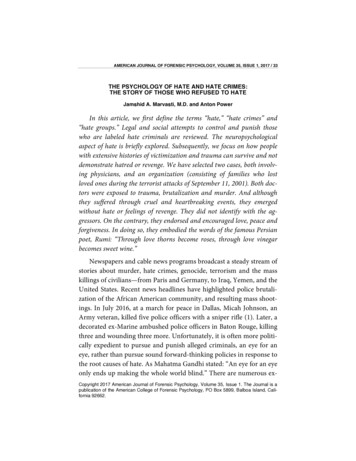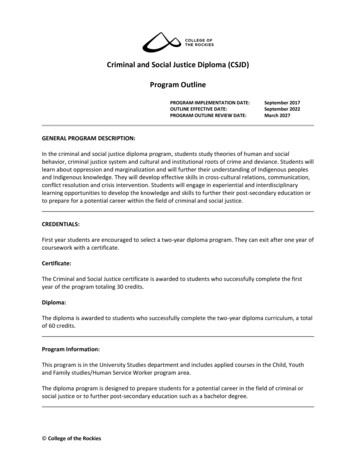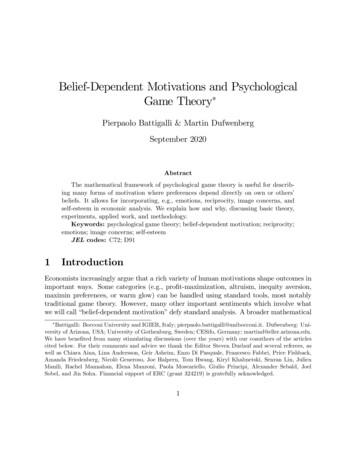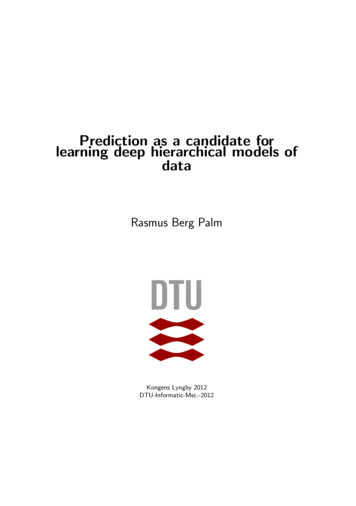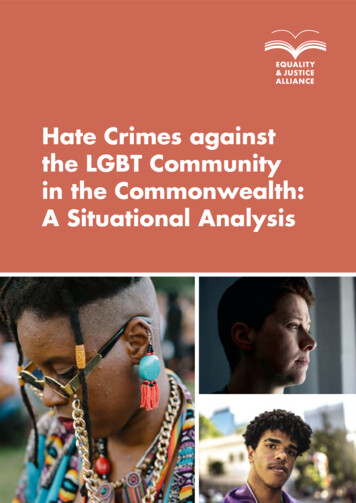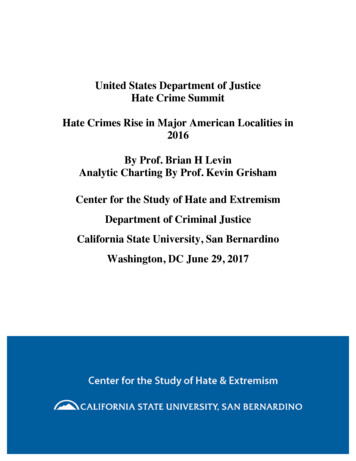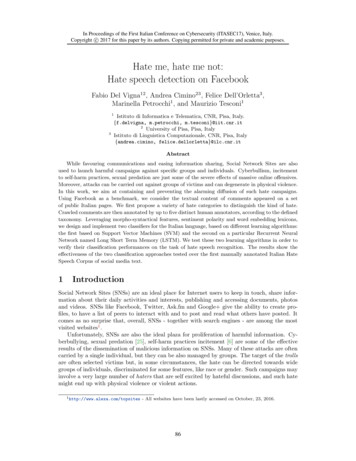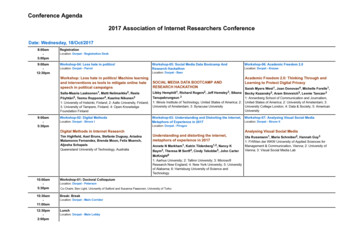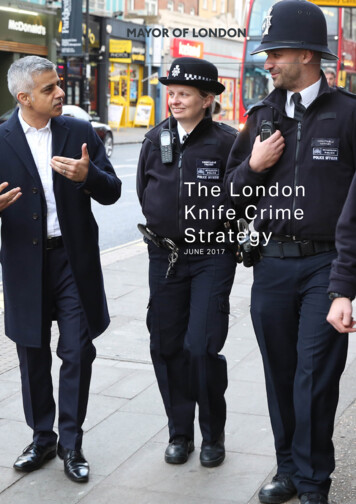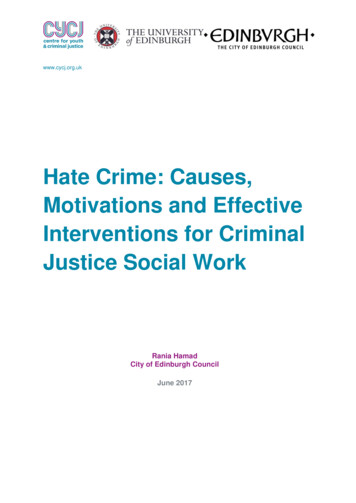
Transcription
www.cycj.org.ukHate Crime: Causes,Motivations and EffectiveInterventions for CriminalJustice Social WorkRania HamadCity of Edinburgh CouncilJune 2017
www.cycj.org.ukContentsAcknowledgements . 3Executive Summary . 4Summary of findings . 41. Glossary of Criminal Justice Social Work Terms . 92. Introduction . 113. Methodology. 134. What is 'hate crime'?. 165. Scope, Nature and Harms of Hate Crime . 186. Causes of hate crime . 317. Characteristics and a typology of hate crime perpetrators. 378. Risk assessment and risk factors . 439. 'What works' in addressing offending in general? . 4810. Hate crime interventions . 5111. 'What works' with hate crime perpetrators – practitioner skills. 6812. Assessment and intervention with perpetrators of hate crime – summary guidancefor practitioners . 7413. Conclusion . 7514. Gaps in knowledge and recommendations . 7815. Bibliography . 81Appendix 1 . 86List of organisations contacted . 86Appendix 2 . 87Client Questionnaire . 872
www.cycj.org.ukThis literature review was written by Rania Hamad, Senior Practitioner, CriminalJustice Social Work at the City of Edinburgh Council.AcknowledgementsI would like to thank Criminal Justice Social Work services within the City of EdinburghCouncil for supporting the research, both at a management level (Stephen Laird, CareyFuller and Harry Robertson), and the Criminal Justice Social Workers consulted. I wouldalso like to thank the other professionals who gave up their valuable time to provide anoverview of the hate crime landscape in Edinburgh, as well as the professionals whocorresponded by telephone and e-mail. Finally, my sincere gratitude is extended to Dr SteveKirkwood and Dr Michael Rosie at the University of Edinburgh for their invaluable support,guidance, and editing skills.3
www.cycj.org.ukExecutive SummaryBackground to the reviewHate crime definition - “a crime motivated by malice or ill will towards a social group”, withfive protected characteristics in Scottish legislation – race, religion, sexual orientation,transgender identity, and disability. The motivation of the perpetrator is key (PoliceScotland; Scottish Government). Increase in hate crime reports - Edinburgh has seen an increase of all reportedhate crimes over the last five years. National and international events, as well aspolitical climates and media rhetoric, can influence rates of hate crime, with areported spike in hate crime following the European Union Referendum vote. Harms of hate crime - research indicates that the trauma experienced by victims ofhate crime can be more enduring and harmful than non-hate related offending, andhate crime also has detrimental effects on communities as well as individuals. Tackling hate crime - “absolute priority” for Police Scotland, as well as the recentannouncement of the review of existing hate crime legislation in Scotland by LordBracadale to ensure it is fit for purpose. Criminal Justice Social Work (CJSW) - how can we strengthen our response inorder to reduce the harm caused to victims and communities, and promote therehabilitation and reintegration of offenders? Current Senior Practitioner role toundertake research into hate crime and explore effective interventions withperpetrators. This document provides a summary of the literature review which wassubsequently produced. Methodology - review of relevant literature, both academic and policy-related,gathering of Edinburgh CJSW data, speaking to practitioners currently working withhate crime perpetrators, and consulting relevant stakeholders and professionals.Guidance was provided via the University of Edinburgh’s Knowledge ExchangeFellowship. Lack of CJSW research - it is apparent from the literature reviewed that there is adistinct lack of research pertaining to Criminal Justice Social Work and how it fits in tothe landscape of tackling hate crime.Summary of findingsScope and Nature of Hate Crime Definitional issues with the term ‘hate’ - perpetrators may not be truly motivatedby hate for their victims, and there is potential for obscuring the everyday, ‘ordinary’experiences of prejudice that people may encounter.4
www.cycj.org.uk Type of hate offences - can range from verbal abuse, damage to buildings andproperty, ‘minor’ violence, sexual offences, exploitation, and very serious violence.Just under half of hate crime victims will know the perpetrator, increasing as much as75% for anti-LGB hate crime. ‘Intersectionality’ adds to the complexity of hate crime - victims may be targeteddue to more than one of their identity characteristics. Hate crime and hate speech on the internet - this is an increasing issue; yet it isunknown if the sharing of hate-based ideologies online leads to offending behaviourin the physical world. Extremist or “mission” offenders - constitute a very small proportion of hateoffenders but they can serve to instil fear and anxiety amongst minority communitiesand can influence wider ideologies and ‘justify’ other forms of hate offending. Gender and the concept of “gendered masculinity” - this is important whenconsidering hate crime, and there can be differential experiences for minority ethnicand LGB women who experience hate crime. Edinburgh CJSW data - 12.4% of the CJSW Reports for Courts completed in 201516 were for a hate offence (236 out of 1900 reports). A Supervision Requirement aspart of a Community Payback Order was the most common outcome (30 recordedOrders), and there was very little use of compensation as a recommended option ordisposal. The small group of practitioners consulted highlighted a gap in theirknowledge of hate crime, risk assessment, and interventions in this area of practice.Causes of Hate Crime The role of prejudice – hate crime is at the ‘extreme end’ of prejudice. Different causes of hate crime - the formation of prejudice and prejudice-relatedoffending can occur at individual and structural levels, linking to the role of shame,social hierarchies, ‘ingroups’ and ‘outgroups’, socio-economic disadvantage,perceptions of threat and loss, and peer group influences, as well as wider politicalrhetoric and the media.Characteristics and a Typology of Hate Crime Offenders The demographics of hate crime perpetrators - some consensus in the literatureon a significant proportion of these being young, white males who may beunemployed or in low-income employment, with their offending potentiallyexacerbated by substance use and with previous convictions for general offending.Nonetheless, reducing offenders to a certain type or category is cautioned against5
www.cycj.org.ukdue to the range of offenders, offences, and causal factors we may deal with. A ‘typology’ of hate crime offenders - proposed by McDevitt et al in 2002: ThrillSeeker; Defensive; Retaliatory; and Mission offenders, with thrill-seekers being themost common. This does not fully account for offences against disabled people,where exploitation may be a key motivation.Risk Assessment and Risk Factors Very little research on risk assessment and hate crime perpetrators - the reviewmainly draws on the work undertaken by the London Probation Trust in this area. Dynamic risk factors - offenders tend to minimise and deny the aggravatedoffending and engage in victim-blaming; have an absence of victim empathy anddistorted sense of provocation, leading to a tendency towards violence as a form ofconflict resolution; and have a sense of entitlement and alienation and a poor senseof their own identity, as well as a distorted idea about the victim and perceiveddifference. Risk assessment should be multi-agency - including housing and anti-socialbehaviour teams where relevant, and include some form of checklist or questionnairein an attempt to measure offenders’ levels of prejudice at the pre-sentence stage.The level of intervention required, and the need for focused work on the hate elementof the offending, is then determined. A full assessment is significantly aided byaccess to victim statements, which does not occur with CJSW in Scotland. Restorative justice and risk assessment - current risk management processesshould not hinder the application of restorative justice or practices with victims andoffenders.‘What Works’ with Hate Crime Interventions An overview of nine hate crime interventions for perpetrators - (in Scotland,England, and Northern Ireland) highlighted that the main Scottish programme,ADAPT, is not widely-known amongst practitioners, and the only Scottish-based hatecrime programme within a custodial environment is no longer in operation. Limited research and evaluations - It is evident that there has been very limitedresearch and evaluation undertaken in relation to the true efficacy of most of theprogrammes. Key features of ‘successful’ interventions - the incorporation of cultural/diversityawareness (although the educative aspect is counterbalanced with a caution not tostray into ‘preaching’ to offenders); reflecting on attitudes and beliefs; and the impactof hate crime on victims and communities will be essential to any intervention.6
www.cycj.org.uk One-to-one work is viewed as most effective - with the potential for offeringgroupwork should this be deemed necessary and appropriate. Addressing the wider causal factors related to offending in general - this is ofkey importance i.e. addressing criminogenic and other needs and promoting therehabilitation and reintegration of offenders, as with all CJSW interventions. The addition of restorative practices - (for example, as part of the ‘empathy stage’of an intervention) could lead to better outcomes for victims and a potential reductionin analogous offending. Restorative Justice and Hate Crime pilot - this is therefore being proposed forCJSW in Edinburgh to bring together perpetrators and victims in an attempt toaddress the harm caused.Practitioner Skills, Knowledge and Values Existing skills, knowledge and values in working with hate crime perpetrators CJSW staff in Edinburgh already possess these. The work has parallels with workingwith domestic and sexual offenders. Supervisory relationship with offenders - practitioners should build a supervisoryrelationship characterised by trust, acceptance, understanding, a nonjudgemental/non-labelling approach, pro-social modelling, and appropriatechallenging. Establish ground rules and boundaries - particularly around use of language andattitudes, but allow the offender to identify and express their prejudices as part of theintervention – maintain a balance between this and appropriate challenging. Utilise a structured intervention - such as Anti-Discriminatory Awareness PracticeTraining, and undergo hate crime awareness training as well as being trained in theintervention. Make good use of staff supervision - to discuss the work and any professional orpersonal issues that may arise from it, potentially in particular for staff with theprotected characteristics.Recommendations Legislative review - Criminal Justice Social Work should remain up-to-date with anychanges in legislation, and where possible feed into the review of legislation as aservice at the forefront of working with perpetrators, as well as maintain a presenceon any local and national strategic groups relating to hate crime and the Community7
www.cycj.org.ukJustice Scotland Hub for knowledge, innovation and learning. Training - it will be beneficial for practitioners to undergo training in relation to thenature, harms, causes, and motivations of hate crime, to aid assessment andintervention with hate crime perpetrators, as well as the ADAPT intervention. Risk assessment - the development of a more robust risk assessment in relation tohate crime offenders will be important, finding an appropriate measure to assessprejudice at the pre-sentence stage. Importantly, gaining access to victim andwitness statements would serve to enhance risk assessment and intervention withthis client group and provide a more credible response to the Courts. Brief intervention - there may be scope for the development of a ‘brief intervention’in relation to low-level hate crime, whether this be part of a diversionary scheme or ashort community order. Further discussions with the Crown Office and ProcuratorFiscal Service in examining the feasibility of a diversion scheme could also be ofbenefit. Restorative Justice - further research into the feasibility of restorative justicemeasures with hate crime offenders will be essential, given the proposed RestorativeJustice and Hate Crime pilot for Edinburgh and the onus to engage with victims andcommunities.8
www.cycj.org.uk1. Glossary of Criminal Justice Social Work TermsAPSC: Alcohol Problem-Solving Court – a pilot scheme offering offenders with significantalcohol issues a specific assessment for a CPO with supervision to address their alcohol useand related offending, in partnership with the Edinburgh and Midlothian Offender RecoveryService.Caledonian Programme: A service working with male perpetrators of domestic abuse(groupwork and individual work) subject to a CPO; a service is also offered to thepartner/victim.CIT: Community Intervention Teams – Criminal Justice Social Work teams comprisingCJSWs and managers working with offenders age 18 across Edinburgh (with the exceptionof those working with the DTTO and Resettlement Teams – see below).CJSW: Criminal Justice Social Work.CJSWs: Criminal Justice Social Workers.CJSWR: Criminal Justice Social Work Report – prepared at the pre-sentence stage for theCourts by a Criminal Justice Social Worker to assist the sentencing process, and to provideinformation on CJSW interventions and how these may impact upon offending behaviour.CPO: Community Payback Order – an order imposed by the Court aimed at addressingoffending behaviour and/or undertaking unpaid work in the community; of six months-threeyears duration. CJSWs most commonly work with offenders subject to a ‘SupervisionRequirement’ as part of a CPO.Diversion: A specific CJSW team involved in completing assessments for offendersdiverted from prosecution, and reporting back to the Procurators Fiscal.DTTO: Drug Treatment and Testing Order – an order imposed by the Court aimed atassisting offenders to reduce their drug use and related offending.EPP: Edinburgh Payback Project (now entitled ‘Men’s Group’) – offers groupwork and 1:1work with males aged 18 convicted of general offending and subject to a CPO.LS/CMI: Level of Service/Case Management Inventory – the risk assessment tool used byCJSWs in Scotland to assess risk and need factors for offenders, and create a CaseManagement Plan should the offender be subject to supervision in the community.Resettlement Team: as with CIT but managing homeless/rootless offenders and a higherproportion of offenders in custody.ROLO: Restriction of Liberty Order – an order imposed by the Court which involves a curfewand electronic monitoring (sometimes colloquially referred to as a ‘tag’).9
www.cycj.org.ukSupervised Release Order (SRO): When a sentence of at least one year and less than fouryears in prison is imposed by a Court, an SRO (not exceeding 12 months) may be made.The offender must therefore be supervised by a CJSW upon release on the SRO.Willow Service: A CJSW/NHS trauma-informed multi-disciplinary partnership serviceworking with female offenders on a voluntary and statutory basis.10
www.cycj.org.uk2. IntroductionReports of hate crime in Scotland have continued to rise, with Edinburgh seeing an increaseof all reported hate crimes over the last five years. National and international events, as wellas political climates and media rhetoric, can influence rates of hate crime, with a reportedspike in hate crime following the European Union Referendum vote (Weaver 2016).Furthermore, research indicates that the trauma experienced by victims of hate crime can bemore enduring and harmful than non-hate related offending, and hate crime also hasdetrimental effects on communities as well as individuals. It is therefore apparent fromcontemporary research that there should be an emphasis on the reduction and prevention ofhate crime, with Police Scotland stating that tackling hate crime is an “absolute priority”(Police Scotland 2016; BBC News 2016), and the recent announcement of the review ofexisting hate crime legislation in Scotland to ensure it is fit for purpose (Scottish Government2017).There is a clear role for Criminal Justice Social Work (CJSW) in working with theperpetrators of hate crime in order to reduce harm to victims and communities, and promotethe rehabilitation and reintegration of offenders. As such, the CJSW service in Edinburghdecided to use Section 27 funding, provided by the Scottish Government to supportcommunity sentences, for a Senior Practitioner role to undertake research into hate crimeand strengthen the social work response. From the review of the literature, including veryrecent Scottish-based reviews exploring the prevention of and responses to hate crime,there is no mention of CJSW services and the central role they occupy in this area of policyand practice. When referring to criminal justice agencies within documents, this is largelypertaining to the police, Courts, and the Crown Office and Procurator Fiscal Service – thereis a distinct lack of focus on how CJSW fits in to the landscape of addressing hate crime.This research will identify the ways in which CJSW can work effectively with hate crimeperpetrators across Edinburgh and strive to increase best practice in this area, with the aimof reducing recidivism rates in this category of offending and the harm caused by hate crime.It will also indirectly aim to contribute to providing Courts with an increasingly informed,robust and credible alternative to custody for this type of offending. The research willenhance the existing knowledge, skills and approaches of CJSW practitioners that can beutilised by staff across the city (and perhaps be generalisable to the rest of Scotland) as an11
www.cycj.org.ukaid to working with perpetrators of hate crime. This will be achieved by reviewing relevantliterature, as well as discussions with relevant stakeholders and CJSW practitioners.This literature review therefore has the following aims and objectives: To define ‘hate crime’ and highlight the complexities around definitions; To gain an understanding of the scope and nature of hate crime in Scotland andEdinburgh, and in CJSW within Edinburgh, with a brief outline of the harms of hatecrime; To explore the causes of hate crime, including individual and wider structuralcausation, and to outline the demographics and a typology of hate crime perpetratorsincluding an exploration of risk assessment in this area of practice; To outline existing hate crime perpetrator programmes and explore what can belearned from these and taken forward in relation to effective interventions; To explore ‘best practice’ for practitioners in this area of work and outline key skills,knowledge and values; To highlight gaps in current knowledge and make future recommendations.12
www.cycj.org.uk3. MethodologyLiterature SearchThis report involves a review of the published academic and policy-related research (‘greyliterature’) on hate crime, with a particular focus on its nature and scope in Scotland, thecausation of hate crime, the characteristics of hate crime perpetrators, and effective practicein working with hate crime perpetrators. This included an exploration of some of the existinginterventions for working with this category of offenders.The literature reviewed included journal articles, books, websites, published statistics onhate crime in relation to the aggravated offence types, newspaper articles, policy documents,and publications from non-governmental organisations. Literature was sought utilisingsearch engines such as Google and Google Scholar, and accessing the University ofEdinburgh’s library database, as well as purchasing relevant books on the topic via theallocated budget. Kiteley and Stogdon (2014) was utilised as a general reference in relationto undertaking a literature review in social work. Where possible, a focus was retained ondata within the Scottish jurisdiction, and data pertaining to other areas of the UK or ofEurope were included where these were directly relevant to the scope of the review and/or ofpotential interest to the objectives of the study. This ideally allows the review to relate asdirectly as possible to practice within CJSW in Edinburgh, with a view to being generalisableto CJSW practice on a national level.Furthermore, reviewing the very large volume of literature on the topic of hate crime isoutwith the scope of this study; therefore a Scottish/UK focus was maintained wherepossible. Similarly, a review of ‘hate crime’ as a general topic would not have been possiblewithin the parameters of this study. As such, the search for relevant literature was based onexploring the scope and nature of hate crime in relation to the protected characteristics asset out in Scottish legislation, and information around working with perpetrators given thefocus on increasing practitioner knowledge and awareness of this area of practice.However, due to the paucity of Scottish hate crime interventions, information on this topicfrom England, Wales and Northern Ireland has been included, with some limited referencesto international interventions where relevant.13
www.cycj.org.ukData from Criminal Justice Social Work and PractitionersData was also gathered from CJSW in Edinburgh in order to explore the scope and nature ofhate crime offences being dealt with within the city and to provide a local context for theresearch to aid practitioners, and potentially policy-makers. Statistical data was sought froma Senior Business Analyst within the City of Edinburgh Council, and the information providedincorporated Criminal Justice Social Work Reports (CJSWRs) completed for aggravatedoffences (by type); completed CJSWRs with outcomes of orders; and completed CJSWRsby preferred option. This data is presented later in this report. In addition, an e-mail wassent to CJSW managers for dissemination to practitioners with information regarding thereview and the protected characteristics, and requesting the following information: How many people their teams have on Orders, Licences and in custody for ahate crime; What the specific offences are (broken down into types e.g. violence, disorderetc); Which disposals were recommended by CJSWR authors where a hate crime waspart of the index offence(s); For those clients on Orders or Licences for a hate crime, what interventionsworkers are undertaking with them, if any, and is there any focus on the hatecrime.From this, I identified a cluster of five CJSW main-grade practitioners in the sameCommunity Intervention Team who are currently supervising people with the aggravatedoffence types. I undertook informal office-based discussions with them regarding their workwith perpetrators, again in order to provide further relevant context for the research, draw outthemes from the literature, and gauge levels of practitioner confidence in this area ofpractice. I also undertook informal telephone consultations with two main-grade socialworkers from the female offender service. This report includes no identifiers relating toindividual practitioners.Discussions and correspondence with professionals/stakeholdersIn order to enhance my knowledge and understanding of the scope/nature of hate crime, thecharacteristics of perpetrators, the existing interventions, and where the potential gaps lie, I14
www.cycj.org.ukfelt it was necessary to engage with relevant stakeholders. As such I contacted a widerange of professionals (the full list of the organisations they were drawn from is included atthe end of this report as Appendix 1) and either met with them or had e-mail or telephonecorrespondence. These informants were drawn from Edinburgh, elsewhere in Scotland,England, and Northern Ireland. A small number of stakeholders did not respond, and due tothe time constraints of this project I was unable to follow these up. When consulting withCriminal Justice Social Work across Scotland, I chose to focus on the areas with the highestamount of reported hate offences as per the Crown Office and Procurator Fiscal Servicedata; these were the highest-populated urban areas in Scotland including Glasgow,Edinburgh and the Lothians, Dundee, and Aberdeen. Where relevant, information gatheredfrom these stakeholders is referred to. As with the practitioners, there are no identifiersrelating to specific individuals.Consultation and guidance throughout the project was also provided via the KnowledgeExchange Fellowship at the University of Edinburgh, as was access to university resources.Limitations of the researchThe remit of this research has not included gathering data directly from victims of hate crime,and due to the focus on working with perpetrators, significant information on victimcharacteristics and victims’ voices is not included – this invaluable information can beaccessed via other publications (for example, McBride 2016; SAREC 2017). Similarly,perpetrators of hate offences have not been contacted directly as this was not within theremit of this review.Primary reviews of hate crime interventions have not been undertaken; rather, reviews ofexisting interventions have been explored and referred to in order that key points aroundeffective practice for practitioners can be extrapolated. Furthermore, due to the extensivescope of this topic and the amount of literature that has been produced, it has not beenpossible to review all of the literature on prejudice and hate crime. Rather, the majority ofthe literature has been selected on the basis of its relevance to staff for awareness-raisingand practice in this field.15
www.cycj.org.ukThe list of stakeholders who were contacted is by no means exhaustive and is intended toprovide a snapshot of key stakeholders and practitioners in relation to working withperpetrators and addressing hate crime in Edinburgh.It should also be noted that the data provided by the City of Edinburgh Council SeniorBusiness Analyst does not include offences pertaining to the Offensive Behaviour at Footballand Threatening Communications (Scotland) Act 2012 Section 6.4. What is 'hate crime'?The term ‘hate crime’ has become embedded within the criminal justice field and is usedextensively in the media. However, the literature highlights that there are definitional issueswith this term and it is unclear as to what it truly entails (Walters et al 2016a; Roberts et al2013). One of the key issues centres around the use of the word ‘hate’ itself, with Walters etal (2016a: 11) arguing that “a person who commits a ‘hate crime’ need not actually bemotivated by hatred for his or her victim, but rather it is his or her expression of prejudice orbias against the victim’s (presumed) group.” McBride (2016: 10) goes on to highlight thatthe term ‘hate crime’, as an expression of an individual’s “poor values” and prejudicedattitudes, masks the social and structural roots of prejudice as well as obscuring the“ordinariness of everyday prejudice in terms of verbal abuse and incivility; pity andsympathy; or unwittingly derogatory language”.The Independent Advisory Group (2016) emphasise that there is no specific formal offenceof ‘hate crime’ in Scotland; rather such offences are classified as being aggravated by‘prejudice’ and may attract stronger penalties as a consequence. Iganski and Lagou (2015)highlight that some critics assert that the stronger penalties imposed on hate crimeperpetrators are akin to “the state criminalizing the expression of certai
Utilise a structured intervention - such as Anti-Discriminatory Awareness Practice Training, and undergo hate crime awareness training as well as being trained in the intervention. Make good use of staff supervision - to discuss the work and any professional or personal issues that may arise from it, potentially in particular for staff with the
